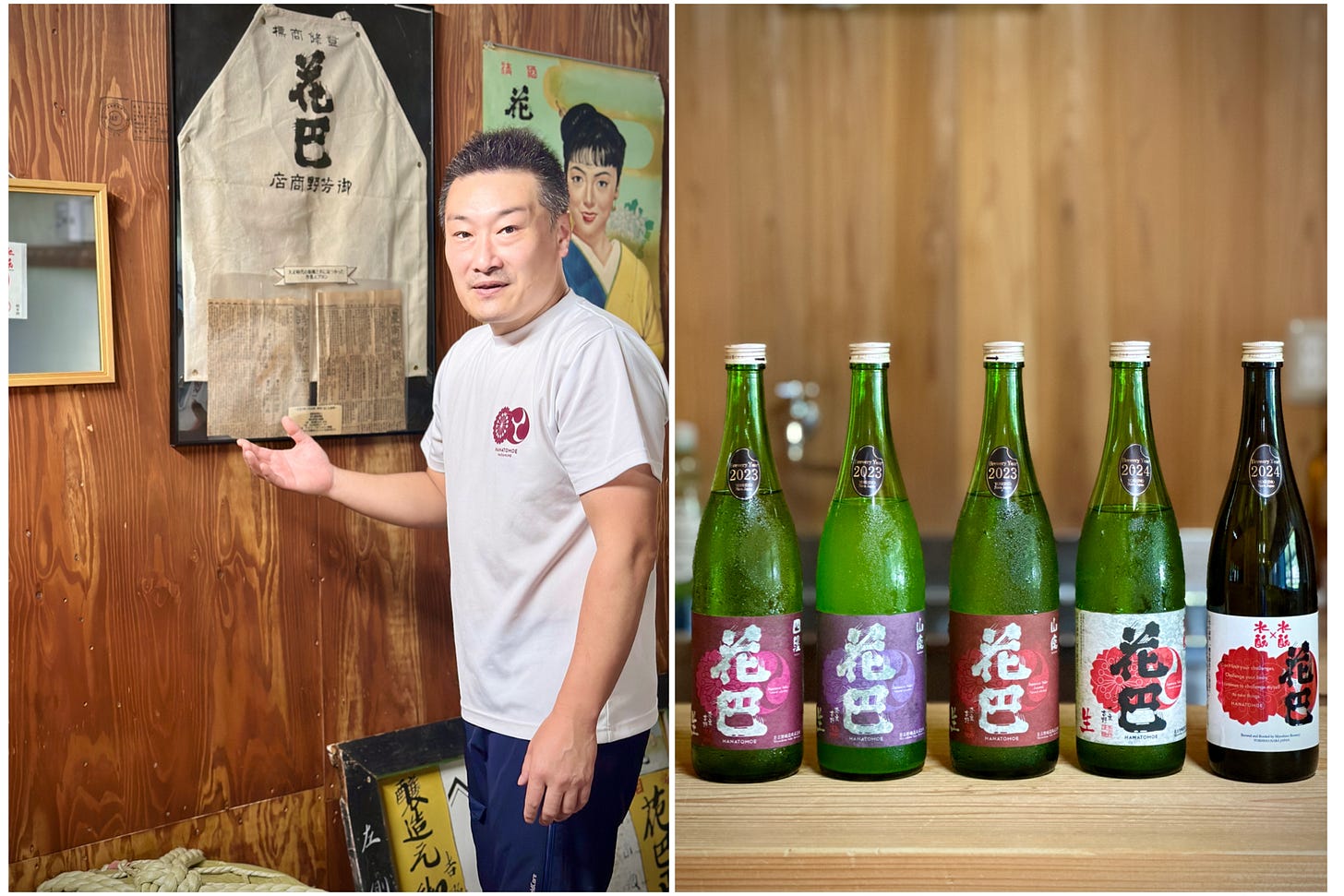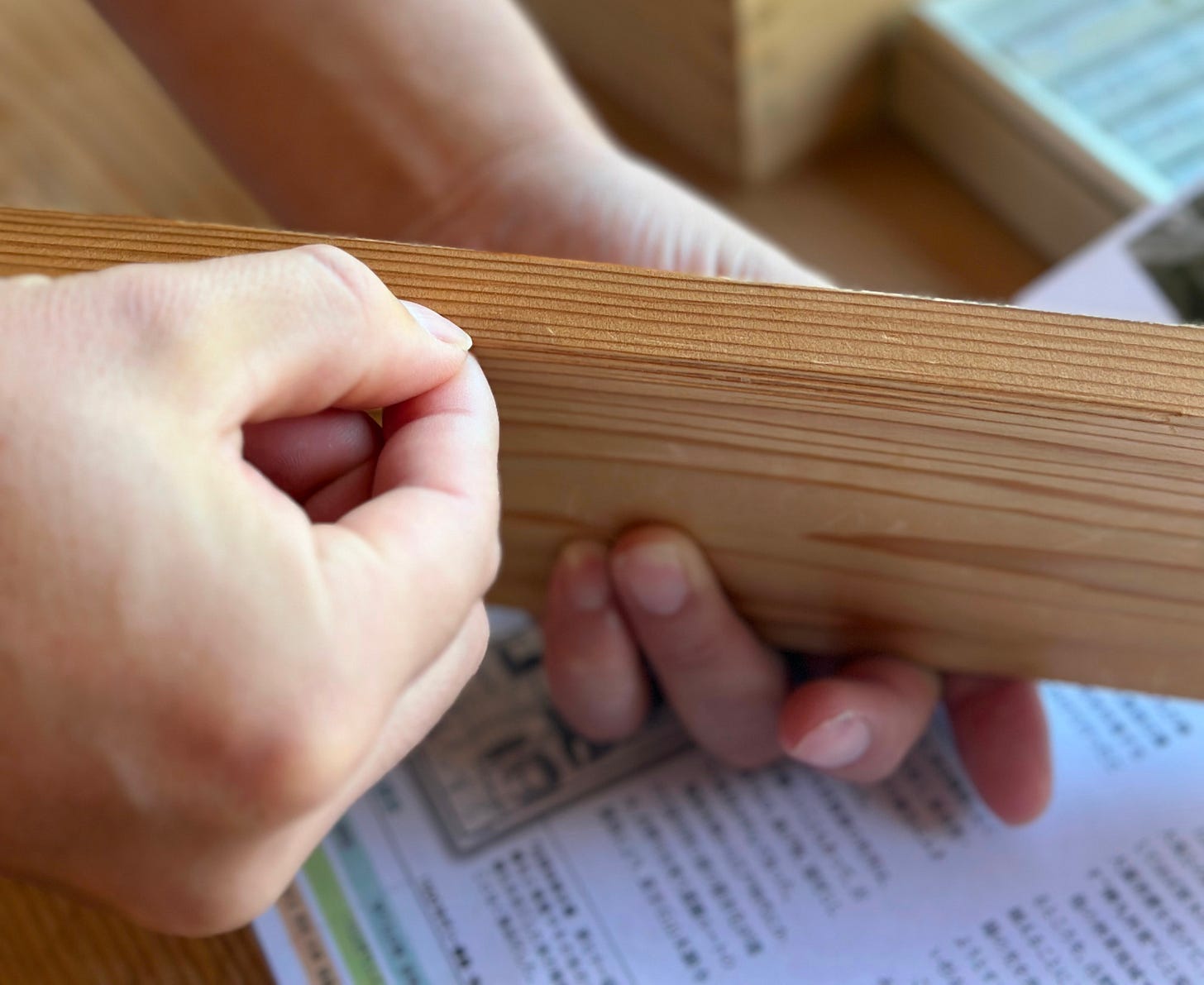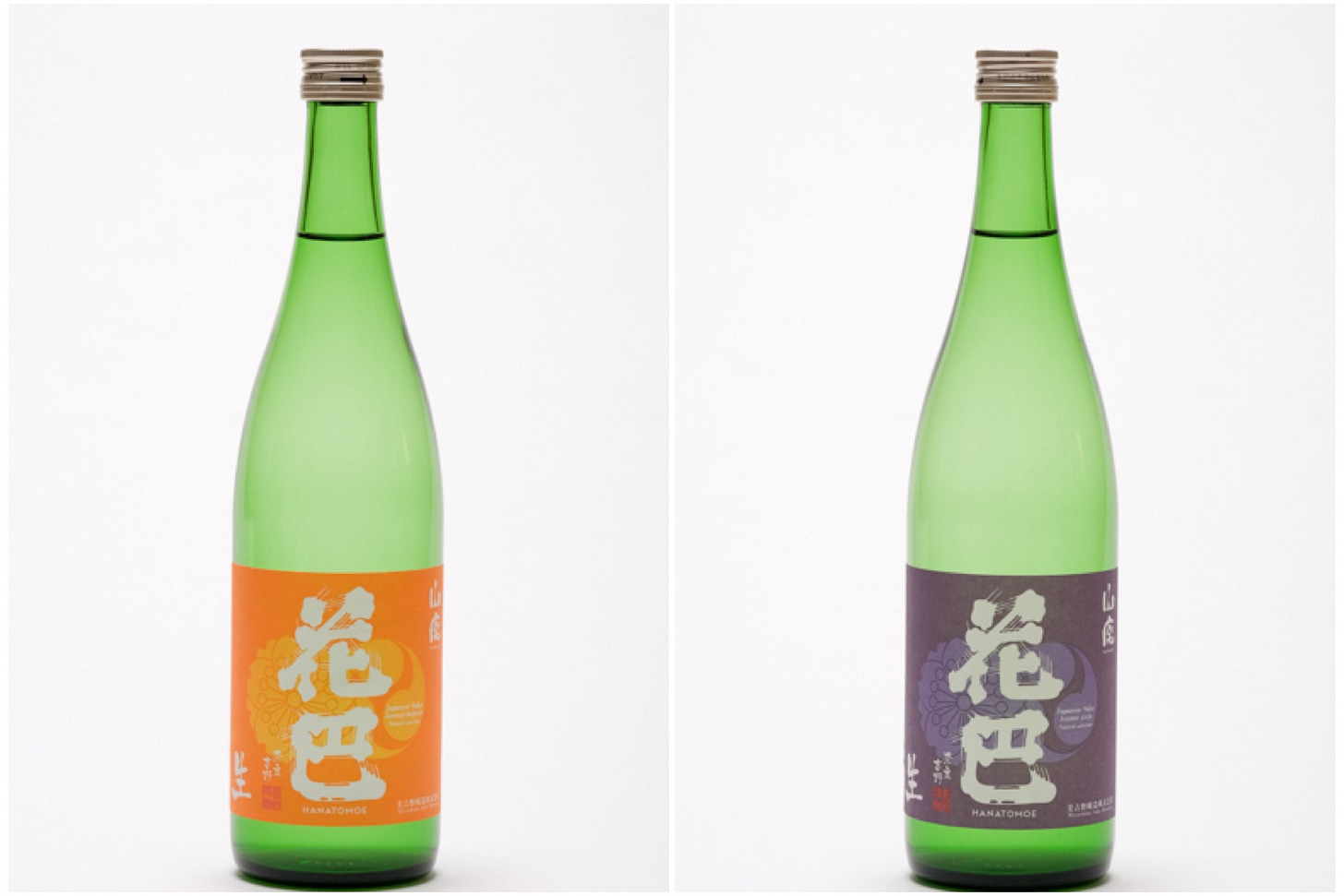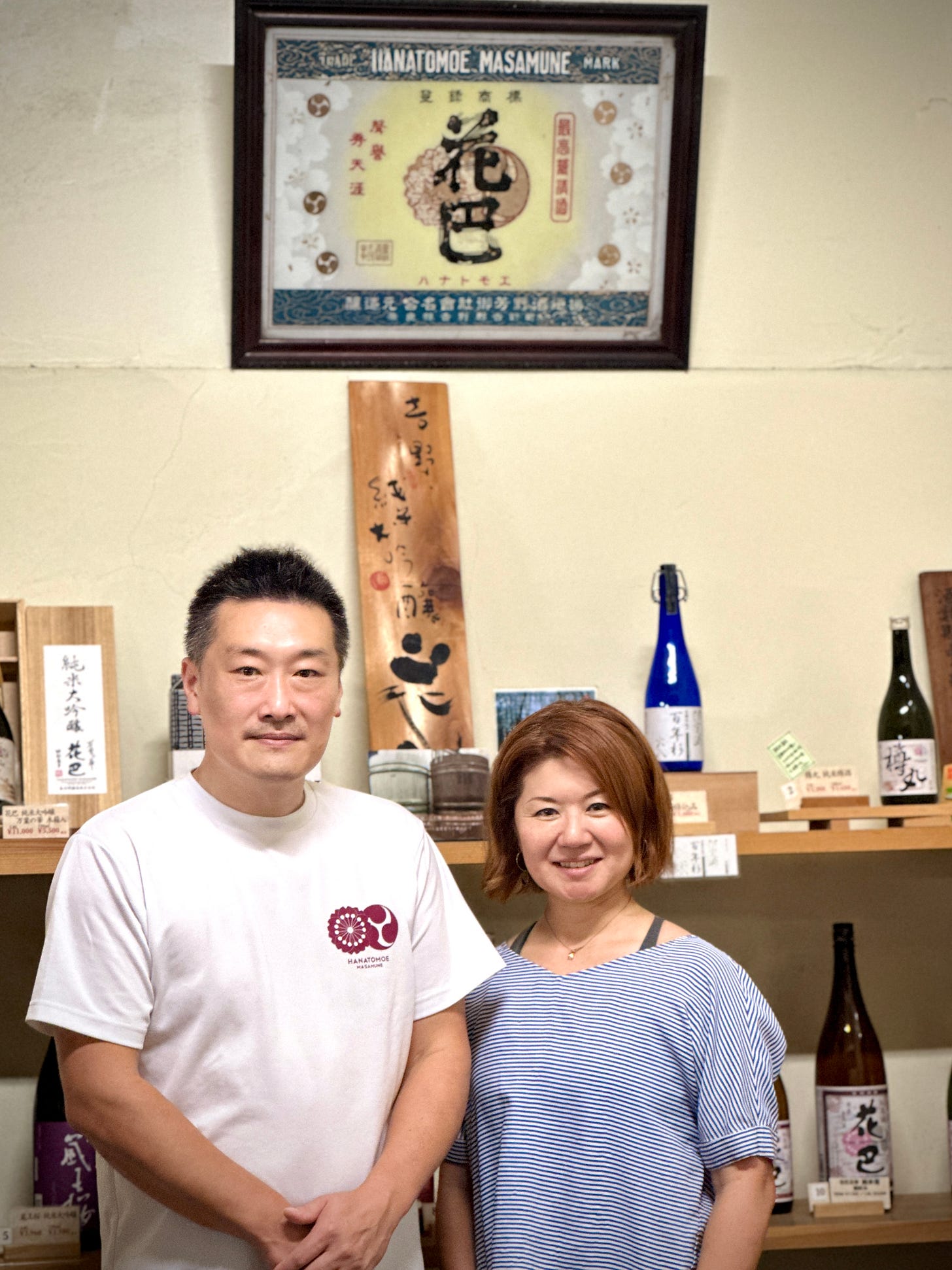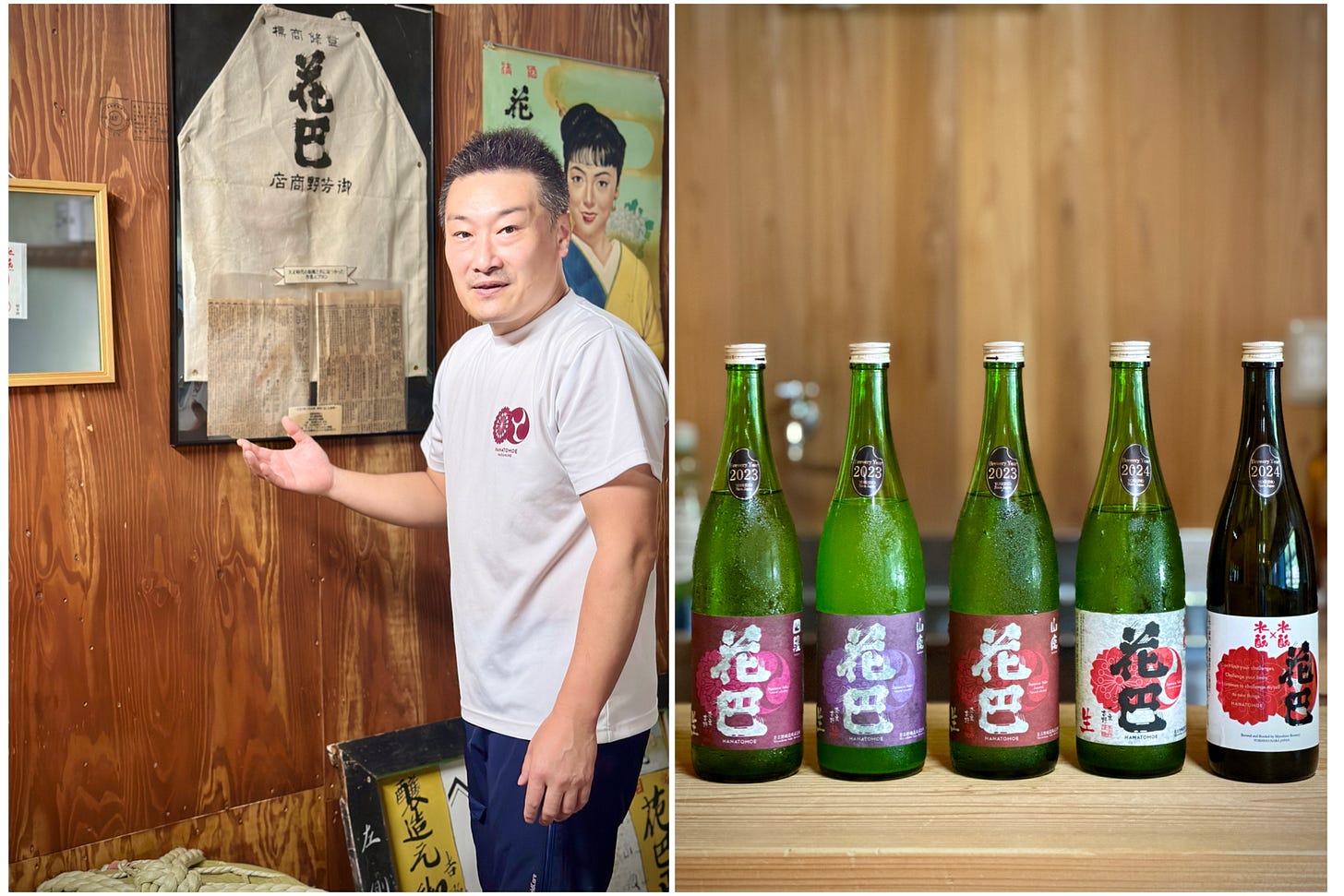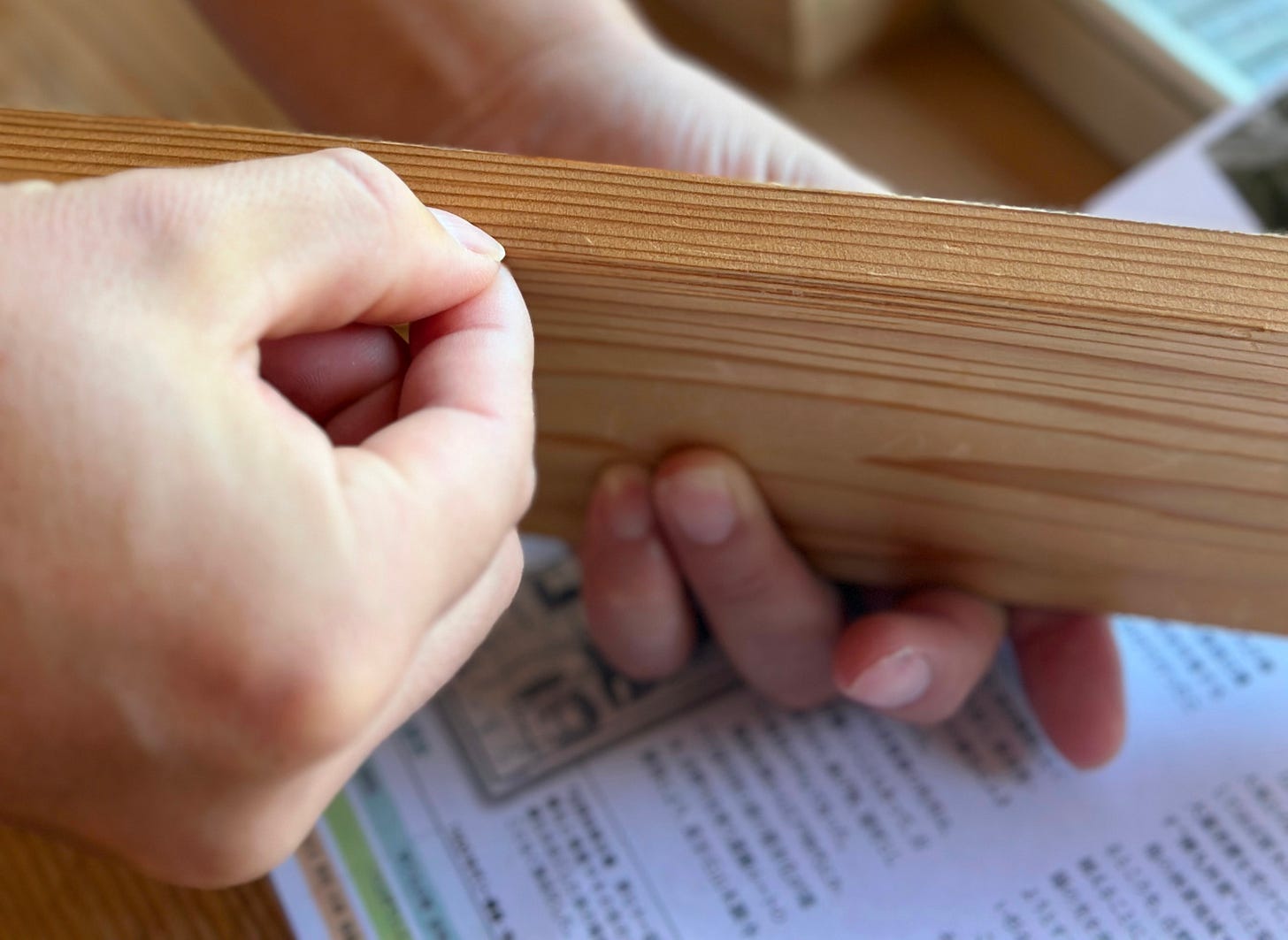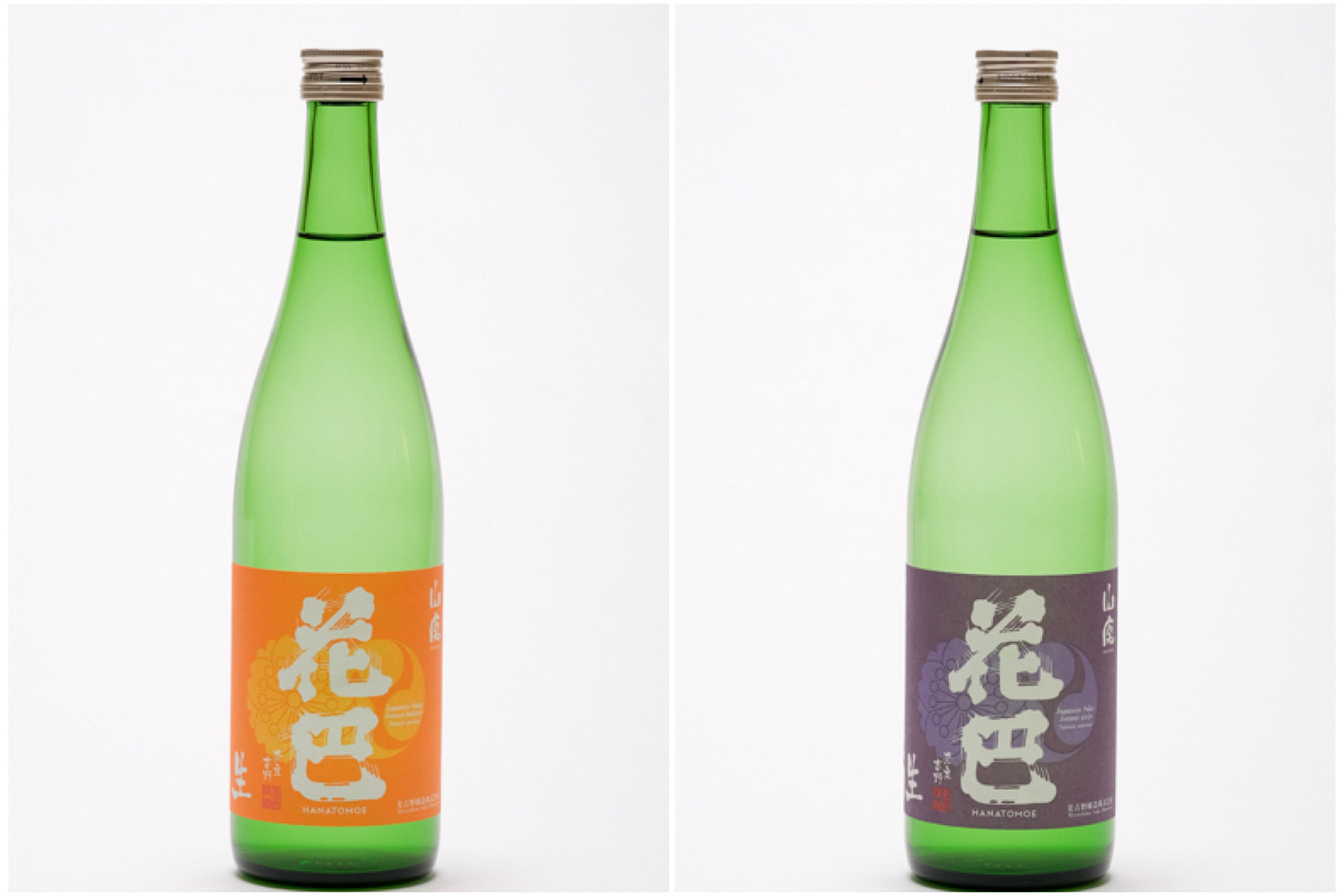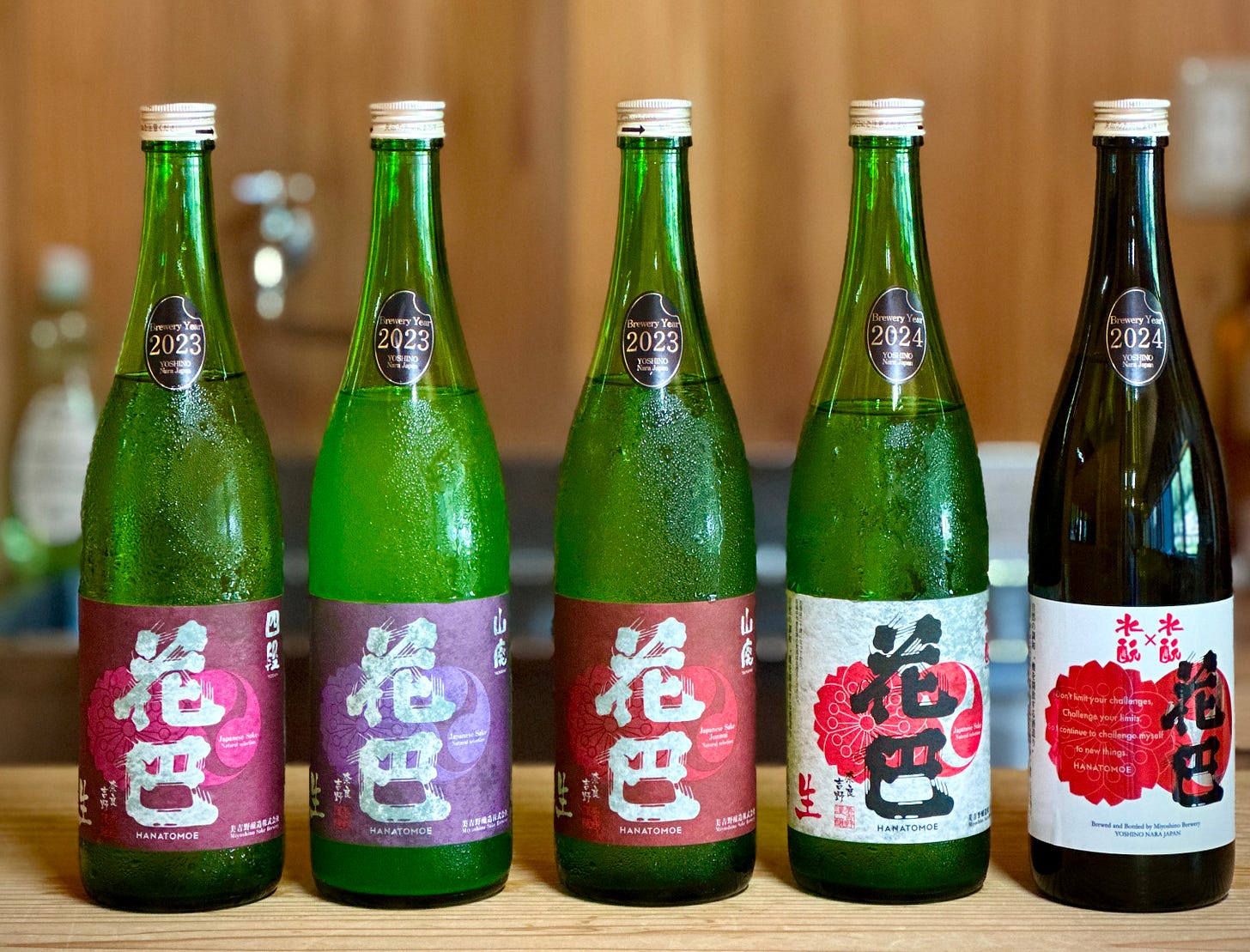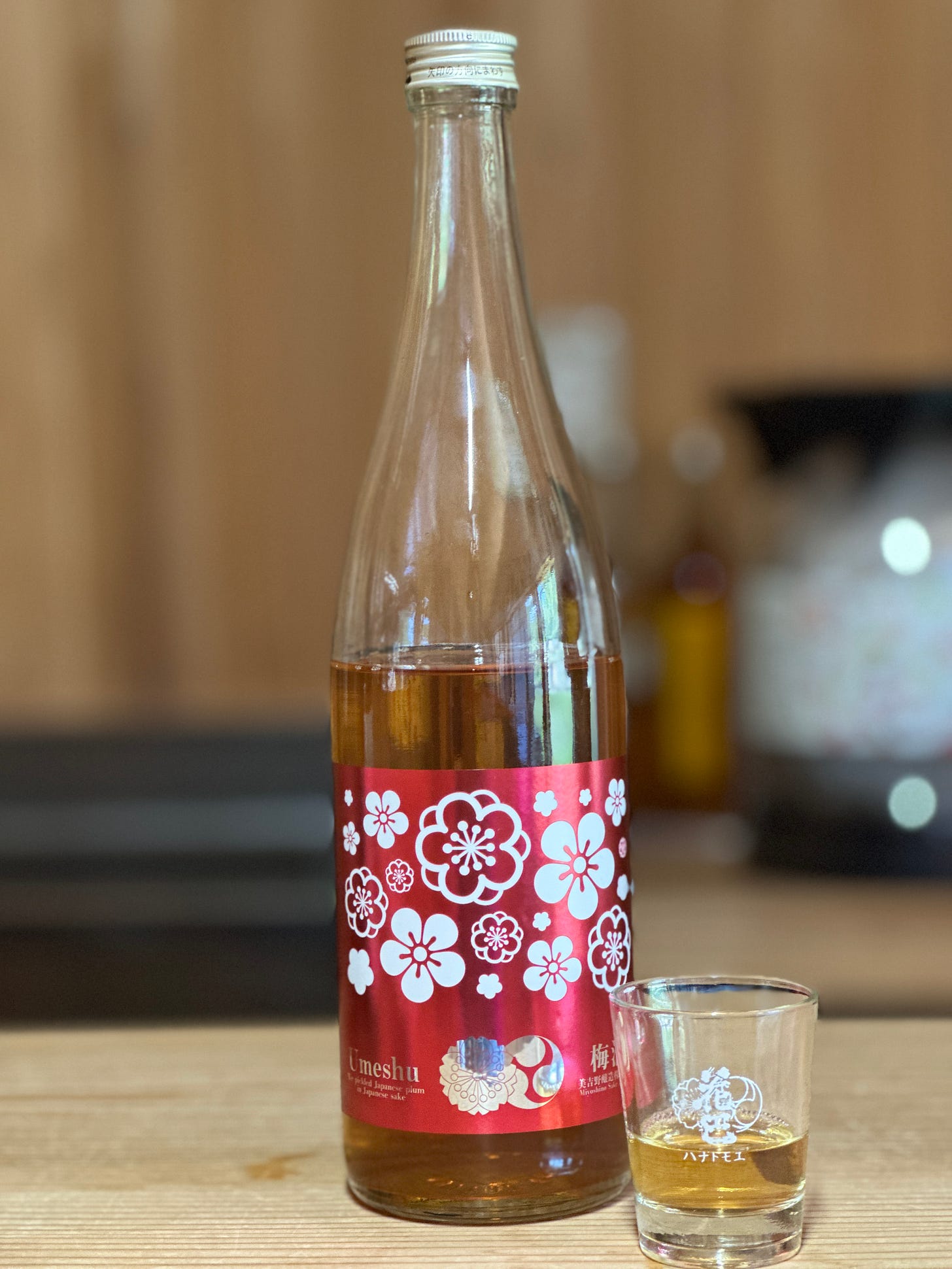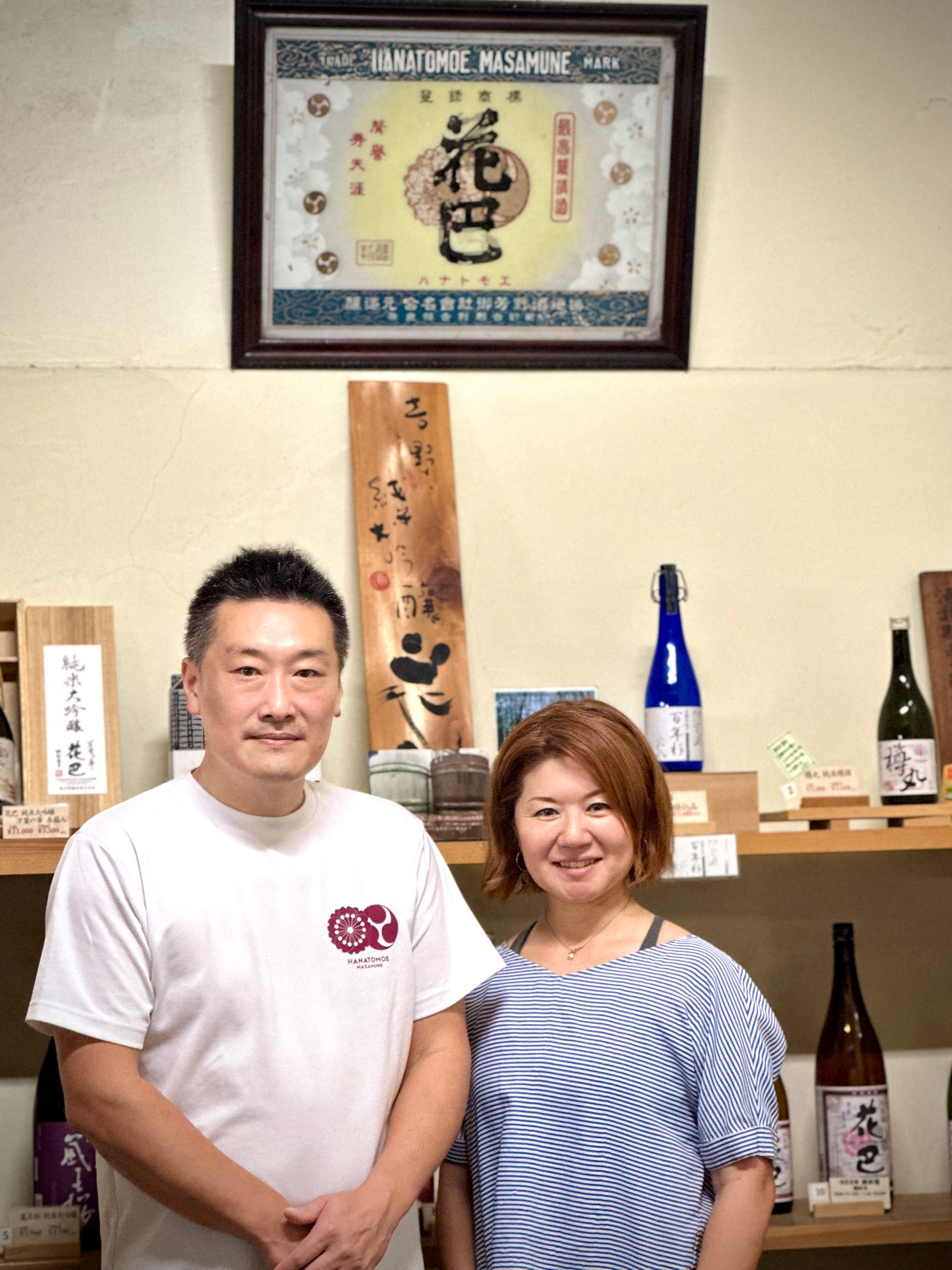Sake Interview #6: Hanatomoe (Miyoshino Brewery)
Wild Yeast and High Acidity Define Sake's New Frontier
🇯🇵 日本語版は記事の下部にあります / Japanese version available below
Hanatomoe's sharp acidity caught me completely off guard. With an acidity level around 3.0 to 4.5, it's more than double that of typical sake. This bold character represents Miyoshino Brewery's distinctive approach, born in Yoshino—a region famous for forestry, not rice cultivation.
I visited Miyoshino Brewery in Yoshino, Nara Prefecture, on a hot August day. This small brewery sits beside the Yoshino River and carries on the name "Hanatomoe" from a sake brewery that once stood at Mount Yoshino, a sacred site for mountain ascetics, until it was lost to fire in 1912. Current brewery owner Teruaki Hashimoto shared his brewing philosophy, one shaped by both the constraints and possibilities of this mountainous land.
📍 Who This Article Is For
·Sake enthusiasts (beginner to intermediate) wanting to understand sake's diversity
Wine lovers interested in regional expression and terroir
Those interested in traditional industries and regional revitalization
People curious about sustainable brewing and agriculture
I'm Kazumi, a DipWSET and educator based in Amsterdam. With a background in wine and sake, I translate sake through a wine-savvy lens.
The Turning Point: Learning from Yoshino Cedar's Dense Planting
Miyoshino Brewery is a small sake brewery nestled deep in the mountains of Yoshino, Nara. When Hashimoto returned home in 2010, his encounter with local forestry workers became a turning point. While exploring the possibility of using Yoshino cedar for sake brewing barrels, he discovered the region's unique dense planting forestry method.
Yoshino cedar has remarkably fine growth rings because of this "dense planting" technique. Foresters plant cedar trees at three times the normal density, forcing them to compete for nutrients and sunlight. This competition suppresses their growth. After 100 years, this slow growth produces incredibly dense, high-quality timber. The process is both natural and artificial—a human-managed forest that works in harmony with nature's principles.
"When humans understand natural principles and guide them appropriately, the characteristics of the land emerge naturally," Hashimoto explains. This revelation fundamentally changed his approach to sake brewing.
Forestry requires thinking in 100-year cycles, which naturally enforces sustainable practices. The forestry workers he met spoke in terms of generations—what their grandfathers planted, what their grandchildren would harvest. "I want to work with farmers' next generation, and the generation after that," Hashimoto told me, adopting this long-term perspective for his brewery.
Hanatomoe's Philosophy: Turning Constraints into Character
Yoshino in Nara Prefecture is famous for forestry, not rice cultivation. The mountainous terrain doesn't suit large-scale agriculture, so local farmers grow multiple crops—persimmons, plums, onions—alongside small quantities of rice. Rice remains precious here, a stark contrast to Japan's major rice-producing regions.
In conventional sake production, brewers polish away rice's outer layers containing proteins, fats, and vitamins, keeping only the starch-rich core. While these outer layers contain amino acids that can add umami, they can also create off-flavors if not handled properly. Standard sake uses rice polished to 70% or less of its original size. Premium daiginjo requires polishing to 50% or less, as competition judges favor these refined, delicate flavors. Some breweries have pushed this to extremes—Niizawa Brewery's "Reikyo Absolute 0" achieves a 0.09% polishing ratio. This "polishing competition" drives up costs dramatically since most of the rice grain is literally thrown away.
But Yoshino's farmers saw this differently.
"When I showed farmers our daiginjo polished to 50%, they said 'what a waste,'" Hashimoto recalls. "I realized that what we brewers consider quality, farmers see as wasteful."
This perspective shifted everything. Instead of pursuing extreme polishing, Hashimoto keeps his rice at around 70% and focuses on completely dissolving it during fermentation. Through careful koji cultivation and fermentation management, he converts all the rice starch into sugar and eventually alcohol. This approach produces Hanatomoe's signature high acidity—a bold, distinctive character rather than delicate refinement.
Hanatomoe takes this philosophy further by not specifying rice varieties on their labels—unusual in a world where premium sake often highlights specific cultivars like Yamada Nishiki. Miyoshino Brewery works with 10 contract farmers whose rice varies significantly in hardness and water absorption. Each batch requires individual adjustments during processing.
"We don't cut corners in processing each farmer's rice differently," Hashimoto explains. "This extra attention at the beginning makes everything else flow smoothly."
Wild Yeast and No Temperature Control: Embracing Natural Fermentation
Miyoshino Brewery's innovation lies in what they choose not to do: no added yeast and no temperature control for 60% of their production. This approach seems risky in modern brewing, where precision typically ensures consistency.
" Cultured yeast dies when temperatures drop to 5°C," Hashimoto explains. "But wild yeast survives even below 5°C or over 30°C. I chose to trust nature's resilience. "
Their 1200-liter enamel tanks sit at ambient temperature year-round without air conditioning. In Yoshino, this means near 0°C in winter and over 30°C in summer—extreme variations that would terrify most brewers. But Hashimoto embraces these fluctuations as part of the brewing process.
Without temperature control, how do they prevent spoilage? The answer lies in concentration. By maintaining high sugar and extract levels, they create osmotic pressure that suppresses harmful microbes while allowing beneficial ones to thrive. It's the same principle that keeps jam from spoiling despite sitting at room temperature. Hashimoto sees this as another lesson from dense-planting forestry: controlled stress creates quality.
For creating the fermentation starter (shubo), Miyoshino uses two traditional methods that rely on natural lactic acid bacteria rather than adding commercial lactic acid for the 60%. Mizumoto, a technique descended from 15th-century Nara brewing, works even in autumn's warm 20°C temperatures. Yamahai, which literally means "abolishing yeast grinding," thrives in winter's cold. While these traditional starters take 40 days to prepare compared to 14 days for modern quick-starters, yamahai remains usable for three months afterward—a testament to its natural stability.
"Various wild yeasts compete in our tanks," Hashimoto notes. "Only the strongest survive the high concentration environment. It's natural selection for sake."
This approach creates distinct seasonal variations. Autumn batches ferment quickly in 20°C warmth, producing dry, crisp sake. Winter's slow, cold fermentation yields juicy, fruit-forward flavors. Spring's rising temperatures create vigorous fermentation with sharp, edgy characteristics. Each season leaves its signature on the final product—something impossible with temperature-controlled brewing.
Strategic Product Development
Interestingly, the remaining 40% uses the modern quick-starter method with temperature control. Entry-level products like " Jun Dai Dai" and "Usunigori" ferment in temperature-controlled tanks, creating an accessible "familiar flavor" with seasonal characteristics subdued.
This mirrors champagne's non-vintage and vintage approach. The strategy draws people in with approachable flavors, then guides them toward seasonal, wild-fermented expressions.
Tasting Six Hanatomoe Varieties: Yamahai, Mizumoto, and Kijoshu
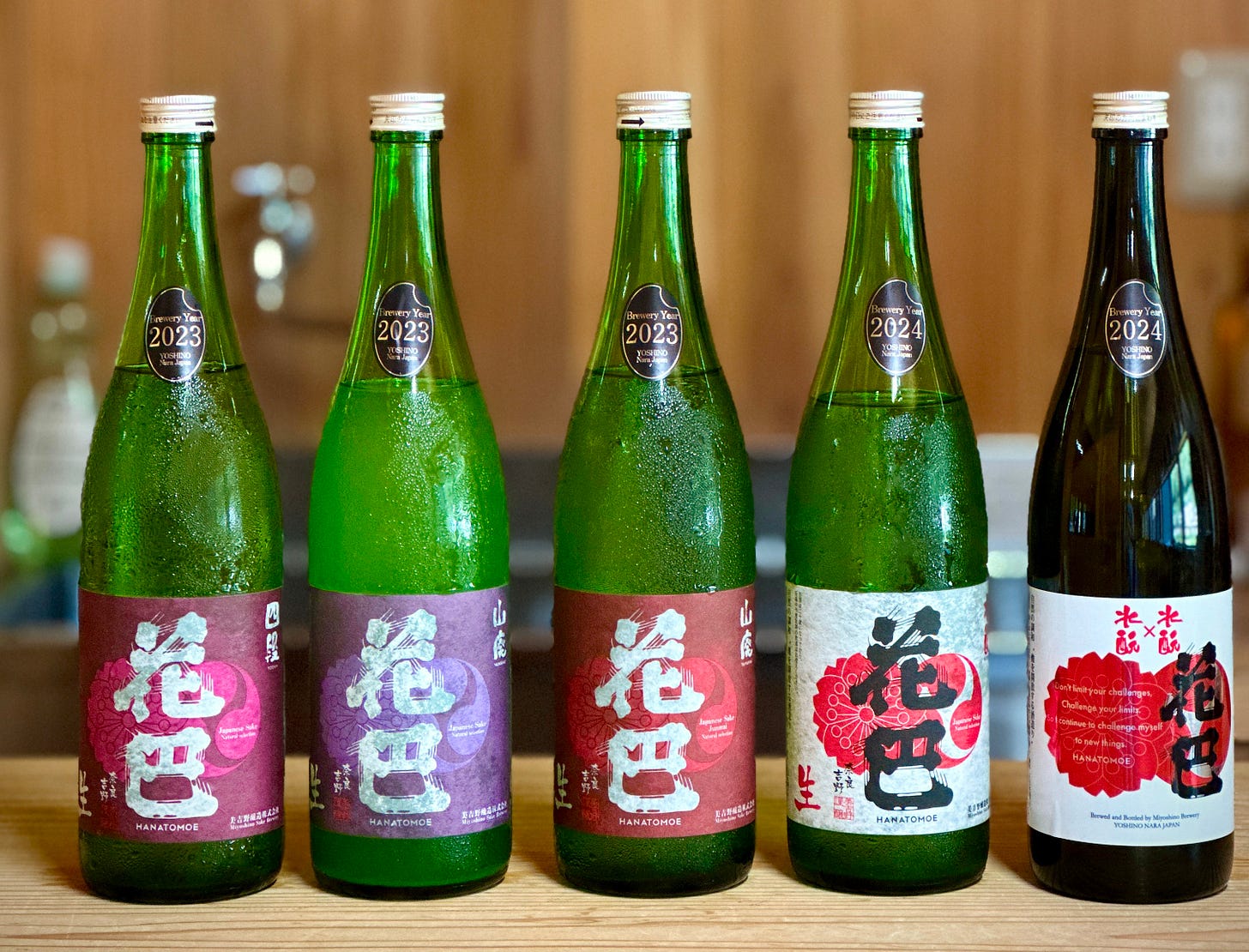
The Hanatomoe lineup I tasted during my visit perfectly embodies Miyoshino Brewery's philosophy of embracing natural variation and high acidity.
1.Hanatomoe Yodan-jikomi Yamahai Junmai Nama (Autumn, Wooden Barrel)
The fourth-stage brewing technique—adding extra steamed rice late in fermentation—creates additional sweetness that balances this yamahai's naturally sharp edges. The result is a sweet-sour profile that works beautifully as an aperitif or dessert sake.
2.Hanatomoe Yamahai Junmai Usunigori Nama (Winter, Enamel Tank)
An entry-level product that doesn't compromise on character. Winter's low-temperature fermentation creates a fruity style with gentle effervescence. The balance of juicy acidity and sweetness makes it approachable even for sake newcomers or those who usually prefer wine.
3.Hanatomoe Yamahai Junmai Nama (Winter, Enamel Tank)
Hanatomoe's flagship winter brew and the brewery's original style. It offers bitterness reminiscent of white grapefruit pith, alongside spice notes and earthiness. The rich, complex flavors develop during an extended 40-60 day fermentation period.
4.Hanatomoe Mizumoto Junmai Nama (Autumn, Enamel Tank)
This showcases mizumoto's characteristic high acidity balanced with rice-derived sweetness. A subtle gamey nuance in the finish unexpectedly reminded me of Burgundian Pinot Noir—a comparison that might help wine drinkers understand its complexity.
5.HANATOMOE Mizumoto × Mizumoto Kijoshu
A luxurious creation where sake replaces water in the brewing process—a technique for creating dessert-style sake. The result offers dense sweetness reminiscent of Sauternes, with burnt caramel aromatics. It pairs brilliantly with blue cheese.
Hanatomoe Umeshu
Kishu Nanko plums macerated in yamahai (21% alcohol). The integration is remarkable—plum and yamahai meld into something entirely new rather than competing for attention.
All six share Hanatomoe's signature high acidity, making them surprisingly accessible to wine drinkers while offering sake enthusiasts something genuinely different.
Pursuing Flavors Beyond Imagination
Hashimoto shared a thought that stuck with me:
"When you travel and encounter unexpected scenery, you're moved. Chain restaurants have predictable flavors, but when a local restaurant amazes you, you think 'I've never tasted this before.' If sake falls within expected parameters, there's no point traveling to drink it."
These words capture the essence of regional sake—it should surprise you, challenge you, make you reconsider what sake can be.
Standing by the Yoshino River after my visit, I reflected on the concept of terroir. Wine directly expresses its land through the grapes that grow there. Sake takes a different path, expressing place through the brewer's interpretation of local conditions and constraints. Neither approach is superior; they're simply different philosophies.
Miyoshino Brewery demonstrates how limitations spark innovation. Their distinctive character doesn't come despite being outside prime rice-growing regions, but because of it. The seasonal variations aren't a flaw of lacking temperature control but the whole point. The wild yeasts aren't unpredictable variables but carriers of local identity.
This philosophy proves especially relevant as climate change and generational farm transitions challenge traditional sake brewing. By embracing diverse production methods and maintaining flexibility, Hashimoto builds resilience into his operation. This long-term thinking mirrors Yoshino's forestry industry, where decisions consider impacts a century ahead.
Some sake can only exist in specific locations. These bottles deserve seeking out, traveling for, experiencing in context. Perhaps this represents regional sake's future—not imitating famous styles but creating something impossible to replicate elsewhere.
Where to Find Hanatomoe
· Japan: Miyoshino Brewery online shop
· Netherlands: Through Yoigokochi (importer)
· Select international markets: Check with specialty sake importers
Thank you to Teruaki Hashimoto for welcoming this visit, and to Dick from Dutch importer Yoigokochi for making it possible.
Glossary
Rice Polishing Ratio: Percentage of rice remaining after polishing. 70% means 30% has been removed.
Acidity: Total acid content in sake. Standard sake ranges 1.0-1.5; Hanatomoe reaches 3.0-4.5.
Shubo (Starter Culture): Concentrated yeast culture prepared before main fermentation begins.
Yamahai: Traditional starter method using natural lactic acid bacteria instead of added lactic acid.
Mizumoto: Nara's traditional starter method, descended from 15th-century bodaimoto technique.
Sohaze: Koji cultivation method that spreads mold throughout rice grains for maximum enzyme production.
Yodan-jikomi (Fourth-stage brewing): Adding steamed rice after the standard three additions to increase sweetness.
Kijoshu: Dessert sake made by replacing water with sake during brewing.
Extended fermentation: Fermenting 40-60 days instead of the standard 25-30 days.
Other Brewery Interviews
· SAKE Interview #5: Gensaka Brewery: Brewing the Future of Rural Japan
· SAKE Interview #4: Hakushika Brewery: Legacy Brewery Pioneering Aged Sake
· SAKE Interview #3: Kirei Brewery: Ultra-Dry Sake with Toji Masahiro Nishigaki
花巴(美吉野醸造)訪問記|奈良・吉野の野生酵母と高酸度が生む日本酒の新境地
奈良県吉野の美吉野醸造「花巴」訪問記。野生酵母と温度管理なしで醸す高酸度(3.0-4.5)の日本酒。山廃・水酛の伝統製法と現代の感性が融合。橋本晃明氏が語る100年先を見据えた酒造りとは。
初めて花巴を飲んだ時、その鮮烈な酸味に驚いた。酸度は体感で3.0から4.5——一般的な日本酒の倍以上はあるだろう。これが米どころではない吉野で生まれた、美吉野醸造が作る「花巴」の独自の答えだった。
奈良県吉野の美吉野醸造を訪れたのは、8月の暑い日だった。吉野川のほとりに立つこの小さな蔵は、明治45年の火事で失われた修験道の聖地・吉野山の酒蔵「花巴」の名を受け継いでいる。現当主の橋本晃明氏が語る酒造りの哲学は、この土地の制約と可能性から生まれていた。
📍この記事を読んでほしい人
日本酒の個性や違いを理解したい初〜中級者
地域性や土地の表現に興味があるワイン愛好家
伝統産業や地域創生に関心がある方
サステナブルな醸造・農業に興味がある方
美吉野醸造の転機:吉野杉の密植林業との出会い
美吉野醸造は、奈良県吉野の山深い地に佇む小規模な酒蔵だ。現在の当主橋本晃明氏が実家に戻った2010年、転機となったのは地元の林業家たちとの出会いだった。木桶プロジェクトへの参加を通じて、吉野杉の密植林業を知ることになる。
「吉野杉の年輪を見てください」と橋本氏は樽材を手に取る。驚くほど細かく均等な年輪。これは通常の3倍の密度で杉を植える「密植林業」の産物だ。木々は栄養を奪い合い、成長が抑制される。100年以上という時間をかけて、極めて緻密な木材が生まれる。
「これは自然であり人工です。人工林ですけど、自然と一体になっている」
「人が自然の摂理を理解し、適切に「誘導」することで、土地の特徴が自然に表れる。」と、橋本氏は語る。
「100年かけて木を育てる林業から学んだのは、無理をしたら続かないということ。祖父の代、孫の代という時間軸で物事を考える。農家さんの次の世代、その次の世代とも一緒にやっていきたい」
そして、この考え方が、酒造りを根本から変えることになる。
花巴の哲学:米どころではない地域の逆転の発想
林業で名を馳せる奈良県吉野は、米どころではない。山深い地形は農業に適さず、この地域の農家は柿や梅、玉ねぎとの複合経営が一般的だ。米は今でも貴重品だという意識がある。
日本酒はタンパク質、脂肪、ビタミンを含む外側を削り、でんぷん質の多い中心部のみを使用する。外側はアミノ酸が多く旨味にもなるが、作り方次第では雑味にもなるからだ。洗練された味わいがコンペティションで評価される傾向があり、通常70%以下、大吟醸と呼ばれるカテゴリは50%以下まで削る。削ることも技術であるため、極限まで削れることを示した0.09%まで削った日本酒も登場した(新澤醸造店「零響」)。精米歩合合戦と表されることもある。当然削り捨てる部分が多いため、必然的にコストが上がり高額になり、高級品として扱われる。ところが吉野での受け止め方は違った。
「50%まで削った大吟醸を農家さんに見せたら『もったいない』と言われました。磨くことが良いという価値観は、立場によって違う」
橋本氏は、考えを変えた。
精米歩合70%に留め、代わりに米を完全に溶かし切る。総破精(そうはぜ)という麹の作り方で、米のデンプンを徹底的に糖化させる。結果として生まれた高い酸度が、花巴の個性となった。
さらに、花巴のラベルには米の品種名を記載しない。米を選ばないという意思表示だ。契約農家10軒それぞれの米の個性——硬さも吸水率も異なる——を、生産者ごとに漬け時間を変えて丁寧に処理する。
「原料処理は面倒くさがらずにやることで、後の工程をスムーズにする」
野生酵母による自然発酵:花巴独自の醸造法
美吉野醸造の革新性は、現代技術を「やらない」選択にも現れている。酵母無添加、そして生産量の約6割で温度管理をしない。
「協会酵母は5度まで下がると死んでしまう。でも野生酵母は30度まで上がっても、5度まで下がっても死なない」
1200リットルの琺瑯タンクは外気温のまま。吉野の気温は冬は0度近く、夏は30度を超える。この変動をそのまま受け入れる。
その代わり、糖分とエキス分の濃度で発酵を制御する。浸透圧で微生物の活動を抑制する——ジャムが腐りにくいのと同じ原理だ。これも密植林業から学んだ手法。濃度で酵母を「抑えつける」ことで、ゆっくりとした発酵を実現する。
酒母づくりには、水酛(みずもと)と山廃(やまはい)という伝統製法を多く採用。水酛は奈良に1400年代から伝わる菩提酛の流れを汲む技法で、秋の高温期でも安全に醸造できる。山廃は冬の低温を活かす製法で、酒母造りに40日もかかるが(速醸なら14日)、その後3ヶ月も使える安定性がある。
「いろいろな酵母がいる中で、濃度を高めて残るものだけが花巴の菌。自然淘汰です」
結果、秋の仕込みは20度前後の温かい環境で速い発酵となりドライに、冬は0度近い低温でゆっくり発酵してジューシーに、春は気温が上がり発酵が活発になってエッジの効いた味になる。季節の個性がそのまま酒に現れる。
戦略的な商品展開
興味深いのは、残り4割は速醸を使い、温度管理することだ。「純橙」「薄にごり」といったエントリー商品は、サーマルタンクで温度を管理し、季節の個性が抑えられた「分かりやすい味」になる。
まさに、シャンパーニュのノンヴィンテージとヴィンテージのような考え方。まず親しみやすい味で、そこから季節ごとの野生的な酒へ導く戦略だ。
花巴全6種テイスティング:山廃・水酛・貴醸酒の個性
訪問時に試飲した花巴のラインナップは、美吉野醸造の哲学を体現していた。
花巴 四段仕込み 山廃純米生酒(秋・木桶仕込み) 四段仕込みで通常より甘く仕上げた山廃。春に仕込んだエッジの強さを甘みで中和し、甘酸っぱい味わい。アペリティフかデザート感覚で。
花巴 山廃純米 薄にごり生酒(冬・琺瑯タンク) エントリー商品の一つ。冬の低温発酵による甘酸っぱさとガス感。口に含んだ瞬間、ジューシーな酸味と甘みのバランス、日本酒が苦手な人でも飲める。
花巴 山廃純米生酒(冬・琺瑯タンク) 花巴の原点となる冬仕込みの定番。グレープフルーツの白い部分のような苦味、スパイス感、土っぽさ。40〜60日という長期発酵による濃厚な味わい。
花巴 水酛純米生酒(秋・琺瑯タンク) 水酛特有のジューシーな酸味と米の甘み。余韻に微かに獣っぽいニュアンスが、ブルゴーニュのピノ・ノワールを思わせる。
HANATOMOE 水酛×水酛 貴醸酒 水の代わりに日本酒で仕込んだ贅沢品。ソーテルヌのような濃厚な甘みと焦がしカラメルの香ばしさ。ブルーチーズとの相性は抜群。
花巴 梅酒 山廃(アルコール度数21度)で紀州南高梅を漬け込んだ梅酒。驚くほど馴染んでおり、梅と山廃が一体化している。
どの酒も酸度が高く、ワインに慣れた舌にも違和感なく受け入れられる。
想像を超える美味しさの追求
橋本氏は言う。
「旅行に行った時、想像もしなかった景色に出会うから感動する。チェーン店なら味が分かってるけど、旅先の定食屋がめちゃくちゃうまかったら『今まで感じたことがない味だ』となる。想像できる範囲のお酒だったら、わざわざ飲む意味がない」
この言葉に、地酒の本質が凝縮されている。
訪問を終えて吉野川を眺めながら考えた。ワインが土地の味をダイレクトに表現するのに対し、日本酒は人の解釈を通じて土地を表現する。それは少し異なるアプローチだ。
美吉野醸造が示しているのは、制約を創造性に変える力。米どころでなくても、だからこそ生まれる個性。温度管理しないからこそ生まれる季節の味。野生酵母だからこそ生まれる土地の味。
気候変動や農家の世代交代といった変化にも、多様な製法と柔軟な姿勢で対応する。これは、100年先を見据えた吉野の林業から学んだ知恵だ。
その土地でしか作れない酒がある。そして、それを飲む価値がある。これこそが、地酒の新たな形なのかもしれない。
花巴を味わうには
オランダ:酔い心地(インポーター)経由
この記事が、新しい日本酒の世界への扉となることを願っている。あなたの「想像外の美味しさ」体験を、#花巴 #美吉野醸造 でシェアしてください。
今回の訪問を受け入れてくださった橋本晃明氏、この機会を実現させてくれたオランダのインポーター酔い心地のディックさんに感謝を。
専門用語
精米歩合:玄米を削って残った割合。70%なら外側30%を削ったことを示す。
酸度:日本酒に含まれる酸の総量。一般的な日本酒は1.0〜1.5、花巴は3.0〜4.5程度。
酒母(しゅぼ):本仕込み前に酵母を大量培養するスターター。
山廃(やまはい):山卸廃止酛の略。自然の乳酸菌を活用する伝統製法。
水酛(みずもと):奈良の伝統的な酒母製法。菩提酛の流れを汲む。
総破精(そうはぜ):麹菌を米全体に繁殖させる製法。米を溶かす力が強い。
四段仕込み:通常の三段仕込み後にもう一度米や麹を加える製法。
貴醸酒(きじょうしゅ):仕込み水の代わりに日本酒を使う贅沢な製法。
長期醪(ちょうきもろみ):通常より長い期間(40〜60日)発酵させたもろみ。
【基本情報】
蔵名:美吉野醸造株式会社
ブランド:花巴(HANATOMOE)
所在地:〒639-3433 奈良県吉野郡吉野町六田1238番地1
代表銘柄:花巴 山廃純米、花巴 水酛純米、HANATOMOE 貴醸酒
特徴:野生酵母、温度管理なし、高酸度(3.0-4.5)
他の酒造インタビューはこちら
SAKE インタビュー#5: 元坂酒造: 農村の未来を醸す:元坂酒造が紡ぐKINOの物語
SAKE インタビュー#4: 白鹿酒造: 老舗酒蔵白鹿が切り拓く古酒の世界
SAKE インタビュー#3: 亀齢酒造:大辛口の日本酒 - 亀齢酒造・西垣昌弘杜氏
SAKE インタビュー#2: 人気酒造:木桶で酒造り:人気酒造の現場から
SAKE インタビュー#1: はじまりの酒:見えないけれど、味わえる樽の中へ
お読みいただき、ありがとうございます!いいね、コメント、重ね読み、購読でサポートしていただけると嬉しいです。



